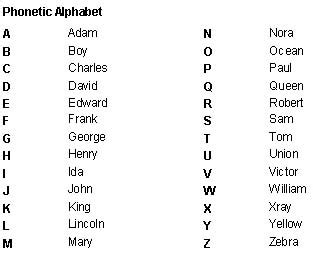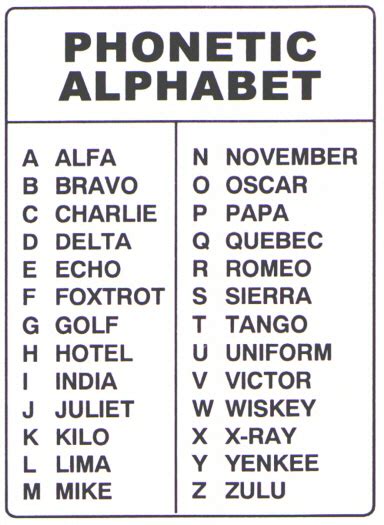The Air Force Phonetic Alphabet, also known as the NATO Phonetic Alphabet, is a standardized system used to clearly communicate letters and numbers over radio and other communications systems, particularly in situations where standard letter pronunciation may be unclear. This alphabet is crucial for maintaining clarity and avoiding misunderstandings in military, aviation, and maritime communications.
Introduction to the Air Force Phonetic Alphabet

The need for a phonetic alphabet arose from the challenges of communicating clearly over low-quality radio connections or in environments with high levels of background noise. The Air Force Phonetic Alphabet was developed to address these challenges by assigning unique and distinct code words to each letter of the English alphabet, as well as to some numbers. This system ensures that messages are conveyed accurately, even under less-than-ideal communication conditions.
History and Development
The Air Force Phonetic Alphabet has its roots in the early 20th century, with various phonetic alphabets being used by different military forces and organizations. However, it was not until after World War II that a standardized phonetic alphabet began to take shape. The International Civil Aviation Organization (ICAO) developed the modern phonetic alphabet in the 1950s, which was later adopted by NATO and other international organizations. Today, this alphabet is widely used not only by military forces but also by civilian aviation, maritime services, and in other contexts where clear communication is critical.
| Letter | Phonetic Alphabet |
|---|---|
| A | Alpha |
| B | Bravo |
| C | Charlie |
| D | Delta |
| E | Echo |
| F | Foxtrot |
| G | Golf |
| H | Hotel |
| I | India |
| J | Juliet |
| K | Kilo |
| L | Lima |
| M | Mike |
| N | November |
| O | Oscar |
| P | Papa |
| Q | Quebec |
| R | Romeo |
| S | Sierra |
| T | Tango |
| U | Uniform |
| V | Victor |
| W | Whiskey |
| X | X-ray |
| Y | Yankee |
| Z | Zulu |
| 0 | Zero |
| 1 | One |
| 2 | Two |
| 3 | Three |
| 4 | Four |
| 5 | Five |
| 6 | Six |
| 7 | Seven |
| 8 | Eight |
| 9 | Nine |

Practical Applications and Benefits

Beyond its military origins, the Air Force Phonetic Alphabet has found widespread use in various fields. In aviation, for example, pilots use the phonetic alphabet to clearly communicate call signs, instructions, and other critical information over radio communications. Similarly, in maritime operations, the alphabet is used to ensure clear communication between ships and coastal authorities. The benefits of using the phonetic alphabet include improved communication accuracy, reduced errors, and enhanced safety in operations where clear communication is critical.
Training and Implementation
Implementing the Air Force Phonetic Alphabet requires comprehensive training to ensure that all users are familiar with the code words and can use them fluently. This training typically involves memorization of the alphabet, practice in using it for communication, and scenarios that simulate real-world applications. In addition to individual training, organizations may conduct drills and exercises to reinforce the use of the phonetic alphabet in team communications.
Key Points
- The Air Force Phonetic Alphabet is a standardized system for clear communication over radio and other communications systems.
- It assigns unique code words to each letter of the English alphabet and some numbers to prevent confusion.
- The alphabet has a history dating back to the early 20th century but was standardized in the 1950s by the ICAO.
- Its use extends beyond military communications to aviation, maritime, and other fields where clear communication is critical.
- Training and practice are essential for effective use of the phonetic alphabet.
In conclusion, the Air Force Phonetic Alphabet is a vital tool for ensuring clear and accurate communication in a variety of contexts. Its development and standardization reflect the importance of precise communication in operational environments. By understanding and applying the principles of the phonetic alphabet, individuals and organizations can enhance the effectiveness and safety of their communications.
What is the purpose of the Air Force Phonetic Alphabet?
+The primary purpose of the Air Force Phonetic Alphabet is to provide a standardized system for clearly communicating letters and numbers over radio and other communications systems, especially in situations where standard letter pronunciation may be unclear.
How is the Air Force Phonetic Alphabet used in real-world applications?
+The Air Force Phonetic Alphabet is used in various fields, including military communications, aviation, and maritime operations, to ensure clear and accurate communication of critical information.
What are the benefits of using the Air Force Phonetic Alphabet?
+The benefits include improved communication accuracy, reduced errors, and enhanced safety in operations where clear communication is critical.
How does one learn the Air Force Phonetic Alphabet?
+Learning the Air Force Phonetic Alphabet involves memorization of the code words, practice in using them for communication, and participation in training exercises that simulate real-world applications.
Is the Air Force Phonetic Alphabet used internationally?
+Yes, the Air Force Phonetic Alphabet, also known as the NATO Phonetic Alphabet, is widely used and recognized internationally, particularly in aviation and maritime communications.



